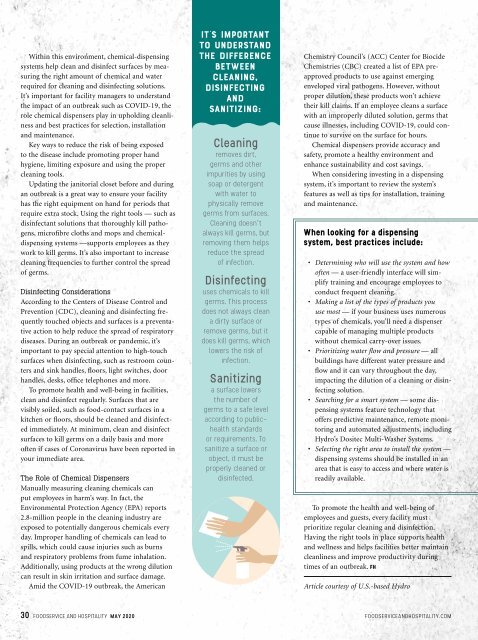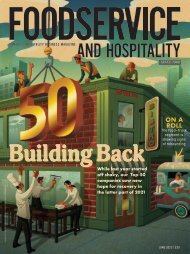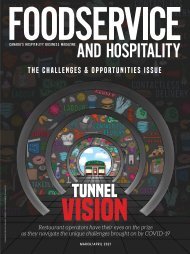May 2020
May 2020 issue of Foodservice and Hospitality magazine.
May 2020 issue of Foodservice and Hospitality magazine.
Create successful ePaper yourself
Turn your PDF publications into a flip-book with our unique Google optimized e-Paper software.
Within this environment, chemical-dispensing<br />
systems help clean and disinfect surfaces by measuring<br />
the right amount of chemical and water<br />
required for cleaning and disinfecting solutions.<br />
It’s important for facility managers to understand<br />
the impact of an outbreak such as COVID-19, the<br />
role chemical dispensers play in upholding cleanliness<br />
and best practices for selection, installation<br />
and maintenance.<br />
Key ways to reduce the risk of being exposed<br />
to the disease include promoting proper hand<br />
hygiene, limiting exposure and using the proper<br />
cleaning tools.<br />
Updating the janitorial closet before and during<br />
an outbreak is a great way to ensure your facility<br />
has the right equipment on hand for periods that<br />
require extra stock. Using the right tools — such as<br />
disinfectant solutions that thoroughly kill pathogens,<br />
microfibre cloths and mops and chemicaldispensing<br />
systems —supports employees as they<br />
work to kill germs. It’s also important to increase<br />
cleaning frequencies to further control the spread<br />
of germs.<br />
Disinfecting Considerations<br />
According to the Centers of Disease Control and<br />
Prevention (CDC), cleaning and disinfecting frequently<br />
touched objects and surfaces is a preventative<br />
action to help reduce the spread of respiratory<br />
diseases. During an outbreak or pandemic, it’s<br />
important to pay special attention to high-touch<br />
surfaces when disinfecting, such as restroom counters<br />
and sink handles, floors, light switches, door<br />
handles, desks, office telephones and more.<br />
To promote health and well-being in facilities,<br />
clean and disinfect regularly. Surfaces that are<br />
visibly soiled, such as food-contact surfaces in a<br />
kitchen or floors, should be cleaned and disinfected<br />
immediately. At minimum, clean and disinfect<br />
surfaces to kill germs on a daily basis and more<br />
often if cases of Coronavirus have been reported in<br />
your immediate area.<br />
The Role of Chemical Dispensers<br />
Manually measuring cleaning chemicals can<br />
put employees in harm’s way. In fact, the<br />
Environmental Protection Agency (EPA) reports<br />
2.8-million people in the cleaning industry are<br />
exposed to potentially dangerous chemicals every<br />
day. Improper handling of chemicals can lead to<br />
spills, which could cause injuries such as burns<br />
and respiratory problems from fume inhalation.<br />
Additionally, using products at the wrong dilution<br />
can result in skin irritation and surface damage.<br />
Amid the COVID-19 outbreak, the American<br />
It’s important<br />
to understand<br />
the difference<br />
between<br />
cleaning,<br />
disinfecting<br />
and<br />
sanitizing:<br />
Cleaning<br />
removes dirt,<br />
germs and other<br />
impurities by using<br />
soap or detergent<br />
with water to<br />
physically remove<br />
germs from surfaces.<br />
Cleaning doesn’t<br />
always kill germs, but<br />
removing them helps<br />
reduce the spread<br />
of infection.<br />
Disinfecting<br />
uses chemicals to kill<br />
germs. This process<br />
does not always clean<br />
a dirty surface or<br />
remove germs, but it<br />
does kill germs, which<br />
lowers the risk of<br />
infection.<br />
Sanitizing<br />
a surface lowers<br />
the number of<br />
germs to a safe level<br />
according to publichealth<br />
standards<br />
or requirements. To<br />
sanitize a surface or<br />
object, it must be<br />
properly cleaned or<br />
disinfected.<br />
Chemistry Council’s (ACC) Center for Biocide<br />
Chemistries (CBC) created a list of EPA preapproved<br />
products to use against emerging<br />
enveloped viral pathogens. However, without<br />
proper dilution, these products won’t achieve<br />
their kill claims. If an employee cleans a surface<br />
with an improperly diluted solution, germs that<br />
cause illnesses, including COVID-19, could continue<br />
to survive on the surface for hours.<br />
Chemical dispensers provide accuracy and<br />
safety, promote a healthy environment and<br />
enhance sustainability and cost savings.<br />
When considering investing in a dispensing<br />
system, it’s important to review the system’s<br />
features as well as tips for installation, training<br />
and maintenance.<br />
When looking for a dispensing<br />
system, best practices include:<br />
• Determining who will use the system and how<br />
often — a user-friendly interface will simplify<br />
training and encourage employees to<br />
conduct frequent cleaning.<br />
• Making a list of the types of products you<br />
use most — if your business uses numerous<br />
types of chemicals, you’ll need a dispenser<br />
capable of managing multiple products<br />
without chemical carry-over issues.<br />
• Prioritizing water flow and pressure — all<br />
buildings have different water pressure and<br />
flow and it can vary throughout the day,<br />
impacting the dilution of a cleaning or disinfecting<br />
solution.<br />
• Searching for a smart system — some dispensing<br />
systems feature technology that<br />
offers predictive maintenance, remote monitoring<br />
and automated adjustments, including<br />
Hydro’s Dositec Multi-Washer Systems.<br />
• Selecting the right area to install the system —<br />
dispensing systems should be installed in an<br />
area that is easy to access and where water is<br />
readily available.<br />
To promote the health and well-being of<br />
employees and guests, every facility must<br />
prioritize regular cleaning and disinfection.<br />
Having the right tools in place supports health<br />
and wellness and helps facilities better maintain<br />
cleanliness and improve productivity during<br />
times of an outbreak. FH<br />
Article courtesy of U.S.-based Hydro<br />
30 FOODSERVICE AND HOSPITALITY MAY <strong>2020</strong> FOODSERVICEANDHOSPITALITY.COM


















